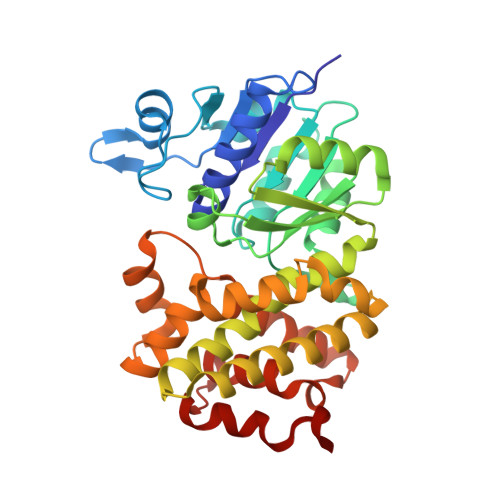Human Glycerol 3-Phosphate Dehydrogenase: X-ray Crystal Structures That Guide the Interpretation of Mutagenesis Studies.
Mydy, L.S., Cristobal, J.R., Katigbak, R.D., Bauer, P., Reyes, A.C., Kamerlin, S.C.L., Richard, J.P., Gulick, A.M.(2019) Biochemistry 58: 1061-1073
- PubMed: 30640445
- DOI: https://doi.org/10.1021/acs.biochem.8b01103
- Primary Citation of Related Structures:
6E8Y, 6E8Z, 6E90 - PubMed Abstract:
Human liver glycerol 3-phosphate dehydrogenase ( hlGPDH) catalyzes the reduction of dihydroxyacetone phosphate (DHAP) to form glycerol 3-phosphate, using the binding energy associated with the nonreacting phosphodianion of the substrate to properly orient the enzyme-substrate complex within the active site. Herein, we report the crystal structures for unliganded, binary E·NAD, and ternary E·NAD·DHAP complexes of wild type hlGPDH, illustrating a new position of DHAP, and probe the kinetics of multiple mutant enzymes with natural and truncated substrates. Mutation of Lys120, which is positioned to donate a proton to the carbonyl of DHAP, results in similar increases in the activation barrier to hlGPDH-catlyzed reduction of DHAP and to phosphite dianion-activated reduction of glycolaldehyde, illustrating that these transition states show similar interactions with the cationic K120 side chain. The K120A mutation results in a 5.3 kcal/mol transition state destabilization, and 3.0 kcal/mol of the lost transition state stabilization is rescued by 1.0 M ethylammonium cation. The 6.5 kcal/mol increase in the activation barrier observed for the D260G mutant hlGPDH-catalyzed reaction represents a 3.5 kcal/mol weakening of transition state stabilization by the K120A side chain and a 3.0 kcal/mol weakening of the interactions with other residues. The interactions, at the enzyme active site, between the K120 side chain and the Q295 and R269 side chains were likewise examined by double-mutant analyses. These results provide strong evidence that the enzyme rate acceleration is due mainly or exclusively to transition state stabilization by electrostatic interactions with polar amino acid side chains.
- Department of Structural Biology , University at Buffalo, SUNY , Buffalo , New York 14203 , United States.
Organizational Affiliation:





















